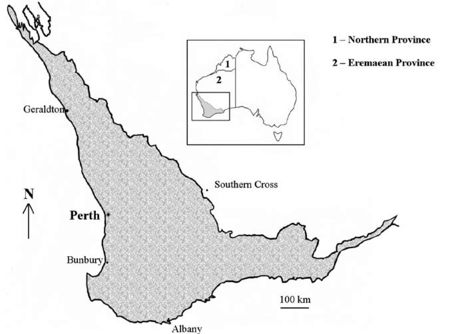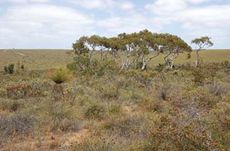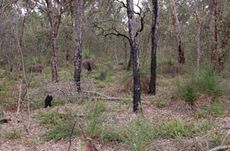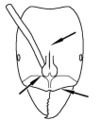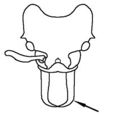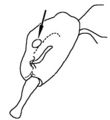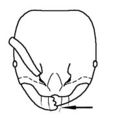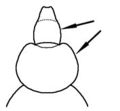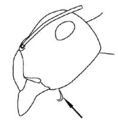Category:SWBP
The southwest region of Australia is renowned for its biological diversity. (https://en.wikipedia.org/wiki/Southwest_Australia). Brian Heterick, working and living in this region for many decades, is the world's foremost authority of the ants of southwestern Australia. He has summarized his vast knowledge of the ants of this region in a wonderful publication: A Guide to the Ants of South-western Australia PDF: part 1, part 2.
Introduction
Heterick begins by stating: The phytogeographic region in Western Australia known as the South-West Botanical Province is well known as a hotspot of mega-diversity for vascular plants (e.g. Beard et al. 2000). However, this region also has a rich ant fauna, with, for example, approximately ten times the number of ant species found in the United Kingdom.
The introduction then describes details of the ant diversity, some of which has now changed with revisions of various subfamilies and genera. Perhaps most importantly, there are more than 500 species present in the SWBP. The keys to species and the discussion of each genera and its constituent SWBP ant species include described species and what are stated to be "all the other morphospecies known from the Province that appear to constitute recognizable species, and are at present allocated voucher numbers in the Curtin Ant Collection. Many of the south-west ants (almost 50%) appear to be undescribed." The obvious problem one might immediately raise in seeing that this treatment of an ant fauna includes so many undescribed species: Wouldn't one assume there are potentially many other species, both undiscovered and undescribed present? The answer . . . "The paucity of novel taxa now being identified by Curtin staff and students, along with myself, suggests that additional species to those covered in this monograph are likely either to be very rare, or at the fringes of a distribution that mostly lies outside of the SWBP."
Habitat
Seven botanical districts, identified by their own distinctive phytogeographic features, can be found within the SWBP. These are the Avon Wheatbelt (AW), characterised by open eucalypt woodland with areas of scrub-heath, the Esperance Plains (ESP), which is mainly mallee-heathland, the Geraldton Sandplains (GS), predominantly scrubheath with some taller trees, the Jarrah forest (JF), which originally was mainly medium-height eucalypt
forest but has now been much modified by farming and urban development, the Mallee (MAL), consisting of eucalypt shrubland, patches of scrubheath and a mosaic of woodland and mallee in the north-east, the Swan Coastal Plain (SWA), originally a mix of jarrah woodland, banksia low woodland, teatree swamps and thicket (Acacia, Allocasuarina and Melaleuca), but which, like the Jarrah forest, has now been much modified by urban development, and, finally, the Warren (WAR), a distinctive wet sclerophyll region of tall forest, including some of the largest trees in WA.
Notes on species Keys
Since the publication of these keys:
- the genus Colobopsis has been removed from its synonymy with Camponotus. Colobopsis species are therefore included in this Camponotus key.
- a species from the genus Amblyopone has been transferred to the genus Onychomyrmex. It is included in the Amblyopone key.
- the key to Paratrechina species now includes species in three genera: Nylanderia, Paraparatrechina, and Paratrechina
- the key to Monomorium species includes the species Trichomyrmex destructor
Keys to Species
Pages in category "SWBP"
The following 37 pages are in this category, out of 37 total.
A
C
D
F
M
- Key to Melophorus of the southwestern Australian Botanical Province
- Key to Meranoplus of the southwestern Australian Botanical Province
- Key to Mesostruma of the southwestern Australian Botanical Province
- Key to Monomorium of the southwestern Australian Botanical Province
- Key to Myrmecia of the southwestern Australian Botanical Province
- Key to Myrmicinae genera of the southwestern Australian Botanical Province
P
- Key to Paratrechina of the southwestern Australian Botanical Province
- Key to Pheidole of the southwestern Australian Botanical Province
- Key to Platythyrea of the southwestern Australian Botanical Province
- Key to Podomyrma of the southwestern Australian Botanical Province
- Key to Polyrhachis of the southwestern Australian Botanical Province
- Key to Ponerinae genera of the southwestern Australian Botanical Province
- Ponerinae of the southwestern Australian Botanical Province
- Key to Prolasius of the southwestern Australian Botanical Province
S
Media in category "SWBP"
The following 200 files are in this category, out of 752 total.
(previous page) (next page)- Heterick 2009 Fig 001.jpg 676 × 502; 34 KB
- Heterick 2009 Fig 002.jpg 805 × 461; 46 KB
- Heterick 2009 Fig 003.jpg 810 × 431; 41 KB
- Heterick 2009 Fig 005.jpg 301 × 136; 6 KB
- Heterick 2009 Fig 006.jpg 248 × 204; 5 KB
- Heterick 2009 Fig 007.jpg 248 × 143; 5 KB
- Heterick 2009 Fig 008.jpg 248 × 134; 5 KB
- Heterick 2009 Fig 009.jpg 212 × 206; 6 KB
- Heterick 2009 Fig 010.jpg 266 × 97; 4 KB
- Heterick 2009 Fig 011.jpg 213 × 208; 5 KB
- Heterick 2009 Fig 012.jpg 248 × 165; 5 KB
- Heterick 2009 Fig 013.jpg 212 × 259; 8 KB
- Heterick 2009 Fig 014.jpg 248 × 183; 4 KB
- Heterick 2009 Fig 015.jpg 213 × 290; 8 KB
- Heterick 2009 Fig 016.jpg 247 × 138; 5 KB
- Heterick 2009 Fig 017.jpg 247 × 138; 4 KB
- Heterick 2009 Fig 018.jpg 212 × 191; 5 KB
- Heterick 2009 Fig 019.jpg 216 × 277; 6 KB
- Heterick 2009 Fig 020.jpg 248 × 124; 5 KB
- Heterick 2009 Fig 021.jpg 213 × 254; 7 KB
- Heterick 2009 Fig 022.jpg 231 × 213; 7 KB
- Heterick 2009 Fig 023.jpg 248 × 286; 10 KB
- Heterick 2009 Fig 024.jpg 213 × 163; 5 KB
- Heterick 2009 Fig 025.jpg 229 × 255; 6 KB
- Heterick 2009 Fig 026.jpg 248 × 154; 5 KB
- Heterick 2009 Fig 027.jpg 176 × 149; 4 KB
- Heterick 2009 Fig 028.jpg 247 × 139; 5 KB
- Heterick 2009 Fig 029.jpg 177 × 118; 3 KB
- Heterick 2009 Fig 030.jpg 247 × 107; 4 KB
- Heterick 2009 Fig 031.jpg 248 × 116; 4 KB
- Heterick 2009 Fig 032.jpg 248 × 129; 5 KB
- Heterick 2009 Fig 033.jpg 248 × 129; 5 KB
- Heterick 2009 Fig 034.jpg 248 × 136; 5 KB
- Heterick 2009 Fig 035.jpg 282 × 139; 5 KB
- Heterick 2009 Fig 036.jpg 248 × 152; 5 KB
- Heterick 2009 Fig 037.jpg 248 × 118; 3 KB
- Heterick 2009 Fig 038a.jpg 213 × 165; 5 KB
- Heterick 2009 Fig 040.jpg 213 × 165; 5 KB
- Heterick 2009 Fig 041.jpg 255 × 115; 5 KB
- Heterick 2009 Fig 042.jpg 248 × 136; 5 KB
- Heterick 2009 Fig 043.jpg 248 × 157; 6 KB
- Heterick 2009 Fig 044.jpg 213 × 223; 5 KB
- Heterick 2009 Fig 045.jpg 213 × 119; 3 KB
- Heterick 2009 Fig 046.jpg 202 × 204; 5 KB
- Heterick 2009 Fig 047.jpg 213 × 276; 7 KB
- Heterick 2009 Fig 048.jpg 213 × 198; 6 KB
- Heterick 2009 Fig 049.jpg 247 × 177; 6 KB
- Heterick 2009 Fig 050.jpg 248 × 170; 6 KB
- Heterick 2009 Fig 051.jpg 213 × 165; 23 KB
- Heterick 2009 Fig 052.jpg 213 × 165; 5 KB
- Heterick 2009 Fig 053.jpg 213 × 145; 4 KB
- Heterick 2009 Fig 054.jpg 213 × 142; 4 KB
- Heterick 2009 Fig 055.jpg 248 × 121; 4 KB
- Heterick 2009 Fig 056.jpg 248 × 146; 4 KB
- Heterick 2009 Fig 057.jpg 284 × 171; 6 KB
- Heterick 2009 Fig 058.jpg 284 × 133; 5 KB
- Heterick 2009 Fig 059.jpg 213 × 225; 7 KB
- Heterick 2009 Fig 060.jpg 213 × 211; 6 KB
- Heterick 2009 Fig 061.jpg 213 × 211; 6 KB
- Heterick 2009 Fig 062.jpg 212 × 206; 7 KB
- Heterick 2009 Fig 063a.jpg 177 × 155; 3 KB
- Heterick 2009 Fig 063b.jpg 248 × 245; 7 KB
- Heterick 2009 Fig 064.jpg 177 × 138; 3 KB
- Heterick 2009 Fig 065.jpg 248 × 255; 5 KB
- Heterick 2009 Fig 066.jpg 249 × 268; 5 KB
- Heterick 2009 Fig 067.jpg 248 × 267; 5 KB
- Heterick 2009 Fig 068a.jpg 177 × 141; 3 KB
- Heterick 2009 Fig 068b.jpg 213 × 290; 8 KB
- Heterick 2009 Fig 069.jpg 177 × 141; 3 KB
- Heterick 2009 Fig 070.jpg 213 × 300; 8 KB
- Heterick 2009 Fig 071.jpg 213 × 258; 7 KB
- Heterick 2009 Fig 072.jpg 230 × 287; 9 KB
- Heterick 2009 Fig 077.jpg 212 × 330; 10 KB
- Heterick 2009 Fig 078.jpg 197 × 254; 7 KB
- Heterick 2009 Fig 079.jpg 213 × 179; 6 KB
- Heterick 2009 Fig 080.jpg 213 × 157; 5 KB
- Heterick 2009 Fig 081.jpg 213 × 234; 7 KB
- Heterick 2009 Fig 082.jpg 197 × 254; 7 KB
- Heterick 2009 Fig 083.jpg 177 × 133; 4 KB
- Heterick 2009 Fig 084.jpg 176 × 149; 4 KB
- Heterick 2009 Fig 085a.jpg 128 × 153; 3 KB
- Heterick 2009 Fig 085b.jpg 213 × 220; 6 KB
- Heterick 2009 Fig 086.jpg 177 × 202; 4 KB
- Heterick 2009 Fig 087.jpg 197 × 254; 7 KB
- Heterick 2009 Fig 088.jpg 213 × 265; 6 KB
- Heterick 2009 Fig 089.jpg 197 × 254; 7 KB
- Heterick 2009 Fig 090.jpg 97 × 160; 2 KB
- Heterick 2009 Fig 091.jpg 122 × 162; 2 KB
- Heterick 2009 Fig 092.jpg 213 × 384; 8 KB
- Heterick 2009 Fig 093.jpg 222 × 237; 6 KB
- Heterick 2009 Fig 094.jpg 213 × 204; 5 KB
- Heterick 2009 Fig 095.jpg 213 × 176; 5 KB
- Heterick 2009 Fig 096a.jpg 212 × 231; 5 KB
- Heterick 2009 Fig 096b.jpg 229 × 203; 5 KB
- Heterick 2009 Fig 097.jpg 248 × 172; 5 KB
- Heterick 2009 Fig 098.jpg 284 × 350; 8 KB
- Heterick 2009 Fig 099.jpg 177 × 229; 4 KB
- Heterick 2009 Fig 100.jpg 176 × 159; 3 KB
- Heterick 2009 Fig 101 and 102.jpg 425 × 168; 11 KB
- Heterick 2009 Fig 103.jpg 213 × 165; 4 KB
- Heterick 2009 Fig 104.jpg 177 × 329; 6 KB
- Heterick 2009 Fig 105.jpg 177 × 208; 5 KB
- Heterick 2009 Fig 106.jpg 225 × 198; 5 KB
- Heterick 2009 Fig 107.jpg 212 × 182; 5 KB
- Heterick 2009 Fig 108a.jpg 213 × 170; 4 KB
- Heterick 2009 Fig 108b.jpg 284 × 155; 5 KB
- Heterick 2009 Fig 109.jpg 213 × 146; 4 KB
- Heterick 2009 Fig 110.jpg 284 × 98; 4 KB
- Heterick 2009 Fig 111.jpg 176 × 176; 3 KB
- Heterick 2009 Fig 112.jpg 158 × 167; 3 KB
- Heterick 2009 Fig 113.jpg 176 × 182; 3 KB
- Heterick 2009 Fig 114.jpg 264 × 259; 7 KB
- Heterick 2009 Fig 115.jpg 213 × 258; 6 KB
- Heterick 2009 Fig 116a.jpg 164 × 152; 4 KB
- Heterick 2009 Fig 116b.jpg 170 × 182; 5 KB
- Heterick 2009 Fig 117a.jpg 213 × 165; 4 KB
- Heterick 2009 Fig 117b.jpg 177 × 185; 5 KB
- Heterick 2009 Fig 118.jpg 314 × 177; 8 KB
- Heterick 2009 Fig 119.jpg 282 × 155; 7 KB
- Heterick 2009 Fig 120a.jpg 177 × 183; 5 KB
- Heterick 2009 Fig 120b.jpg 177 × 261; 6 KB
- Heterick 2009 Fig 121.jpg 213 × 172; 5 KB
- Heterick 2009 Fig 122.jpg 177 × 164; 3 KB
- Heterick 2009 Fig 123.jpg 177 × 208; 4 KB
- Heterick 2009 Fig 124.jpg 176 × 176; 3 KB
- Heterick 2009 Fig 125.jpg 176 × 182; 3 KB
- Heterick 2009 Fig 126.jpg 248 × 136; 5 KB
- Heterick 2009 Fig 127.jpg 248 × 154; 5 KB
- Heterick 2009 Fig 128.jpg 247 × 181; 5 KB
- Heterick 2009 Fig 129.jpg 235 × 162; 5 KB
- Heterick 2009 Fig 130.jpg 178 × 218; 5 KB
- Heterick 2009 Fig 131.jpg 202 × 219; 5 KB
- Heterick 2009 Fig 132.jpg 204 × 241; 6 KB
- Heterick 2009 Fig 133a.jpg 310 × 162; 7 KB
- Heterick 2009 Fig 133b.jpg 222 × 200; 5 KB
- Heterick 2009 Fig 134a.jpg 269 × 149; 6 KB
- Heterick 2009 Fig 134b.jpg 228 × 202; 6 KB
- Heterick 2009 Fig 135.jpg 207 × 233; 4 KB
- Heterick 2009 Fig 136.jpg 207 × 158; 3 KB
- Heterick 2009 Fig 137.jpg 207 × 170; 3 KB
- Heterick 2009 Fig 138.jpg 207 × 176; 3 KB
- Heterick 2009 Fig 139.jpg 207 × 208; 9 KB
- Heterick 2009 Fig 140.jpg 207 × 220; 10 KB
- Heterick 2009 Fig 141.jpg 207 × 183; 3 KB
- Heterick 2009 Fig 142.jpg 207 × 178; 4 KB
- Heterick 2009 Fig 143.jpg 193 × 186; 4 KB
- Heterick 2009 Fig 144.jpg 193 × 177; 4 KB
- Heterick 2009 Fig 145.jpg 151 × 107; 2 KB
- Heterick 2009 Fig 146.jpg 230 × 178; 10 KB
- Heterick 2009 Fig 147.jpg 355 × 201; 6 KB
- Heterick 2009 Fig 148.jpg 355 × 184; 5 KB
- Heterick 2009 Fig 149.jpg 394 × 203; 6 KB
- Heterick 2009 Fig 150.jpg 441 × 210; 6 KB
- Heterick 2009 Fig 151.jpg 163 × 174; 4 KB
- Heterick 2009 Fig 152.jpg 166 × 162; 3 KB
- Heterick 2009 Fig 153.jpg 213 × 223; 5 KB
- Heterick 2009 Fig 154.jpg 249 × 253; 6 KB
- Heterick 2009 Fig 155.jpg 461 × 219; 7 KB
- Heterick 2009 Fig 156.jpg 461 × 193; 7 KB
- Heterick 2009 Fig 157.jpg 200 × 248; 6 KB
- Heterick 2009 Fig 158.jpg 188 × 229; 6 KB
- Heterick 2009 Fig 159.jpg 317 × 221; 5 KB
- Heterick 2009 Fig 160.jpg 300 × 206; 5 KB
- Heterick 2009 Fig 161.jpg 231 × 271; 7 KB
- Heterick 2009 Fig 162.jpg 231 × 257; 6 KB
- Heterick 2009 Fig 163.jpg 223 × 144; 4 KB
- Heterick 2009 Fig 164.jpg 239 × 210; 5 KB
- Heterick 2009 Fig 165.jpg 238 × 203; 5 KB
- Heterick 2009 Fig 166.jpg 283 × 282; 7 KB
- Heterick 2009 Fig 167.jpg 250 × 282; 7 KB
- Heterick 2009 Fig 168.jpg 282 × 162; 6 KB
- Heterick 2009 Fig 169.jpg 273 × 161; 6 KB
- Heterick 2009 Fig 170.jpg 173 × 218; 4 KB
- Heterick 2009 Fig 171.jpg 154 × 231; 4 KB
- Heterick 2009 Fig 172.jpg 256 × 159; 4 KB
- Heterick 2009 Fig 173.jpg 271 × 176; 4 KB
- Heterick 2009 Fig 174.jpg 171 × 129; 3 KB
- Heterick 2009 Fig 175.jpg 284 × 163; 3 KB
- Heterick 2009 Fig 176.jpg 249 × 242; 7 KB
- Heterick 2009 Fig 177.jpg 249 × 243; 6 KB
- Heterick 2009 Fig 178a.jpg 259 × 151; 5 KB
- Heterick 2009 Fig 178b.jpg 175 × 162; 4 KB
- Heterick 2009 Fig 179.jpg 308 × 176; 4 KB
- Heterick 2009 Fig 180.jpg 272 × 162; 6 KB
- Heterick 2009 Fig 181.jpg 176 × 174; 4 KB
- Heterick 2009 Fig 182a.jpg 331 × 194; 5 KB
- Heterick 2009 Fig 182b.jpg 127 × 185; 4 KB
- Heterick 2009 Fig 183a.jpg 331 × 194; 4 KB
- Heterick 2009 Fig 183b.jpg 144 × 174; 4 KB
- Heterick 2009 Fig 184.jpg 231 × 218; 6 KB
- Heterick 2009 Fig 185.jpg 231 × 218; 6 KB
- Heterick 2009 Fig 186a.jpg 186 × 197; 3 KB
- Heterick 2009 Fig 186b.jpg 193 × 193; 5 KB
- Heterick 2009 Fig 187.jpg 186 × 225; 3 KB
- Heterick 2009 Fig 188.jpg 198 × 201; 5 KB
- Heterick 2009 Fig 189.jpg 228 × 201; 5 KB
- Heterick 2009 Fig 190a.jpg 193 × 139; 3 KB
- Heterick 2009 Fig 190b.jpg 204 × 162; 5 KB
- Heterick 2009 Fig 191a.jpg 231 × 179; 3 KB
- Heterick 2009 Fig 191b.jpg 200 × 162; 5 KB
